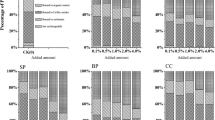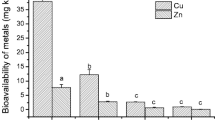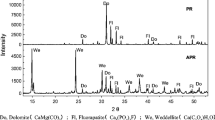Abstract
Synthetic hydroxyapatite (HA) and natural phosphate rock (PR) were applied to heavy metal-contaminated soils from sulfide mine areas in Sardinia and Tuscany (Italy). The application of phosphate amendments to the polluted mine waste soils reduced water-soluble concentrations of Co and Ni by about 99 %. In general, phosphate treatment was slightly more effective in reducing water solubility of Co and Ni in the Sardinian soils than in the Tuscan ones. This result suggests that the mineralogical composition of the mine waste soils may impact the effectiveness of metal immobilization. The formation of complexes of the heavy metals on the surface of phosphate grains and partial dissolution of the amendments and precipitation of heavy metal-containing phosphates are the dominant immobilization mechanisms. Between the phosphate amendments, PR was slightly less effective than HA in immobilizing Co and Ni. This result could be attributed to PR inability to provide soluble phosphate. Although with lower effectiveness, the use of PR to immobilize heavy metals from contaminated soils may reduce the risk of phosphate-induced eutrophication due to the application of amendments with highly soluble phosphate.



Similar content being viewed by others
References
Basta, N. T., Gradwohl, R., Snethen, K. L., & Schroder, J. L. (2001). Chemical immobilization of lead, zinc, and cadmium in smelter-contaminated soils using biosolids and rock phosphate. Journal of Environmental Quality, 30, 1222–1230.
Boisson, J., Ruttens, A., Mench, M., & Vangronsveld, J. (1999). Evaluation of hydroxyapatite as a metal immobilizing soil additive for the remediation of polluted soils. Part 1. Influence of hydroxyapatite on metal exchangeability in soil, plant growth and plant metal accumulation. Environmental Pollution, 104, 225–233.
Boni, M., Costabile, S., De Vivo, B., & Gasparrini, M. (1999). Potential environmental hazard in the mining district of southern Iglesiente (SW Sardinia, Italy). Journal of Geochemical Exploration, 67, 417–430.
Boni, M., Gilg, H. A., Aversa, G., & Balassone, G. (2003). The “Calamine” of southwest Sardinia: Geology, mineralogy, and stable isotope geochemistry of supergene Zn mineralization. Economic Geology, 98, 731–748.
Boonfueng, T., Axe, L., Xu, Y., & Tyson, T. A. (2006). Nickel and lead sequestration in manganese oxide-coated montmorillonite. Journal of Colloid and Interface Science, 303, 87–98.
Brugger, J., McPhail, D. C., Wallace, M., & Waters, J. (2003). Formation of willemite in hydrothermal environments. Economic Geology, 98, 819–835.
Cao, X., Ma, L. Q., Chen, M., Singh, S. P., & Harris, W. G. (2002). Impacts of phosphate amendments on lead biogeochemistry at a contaminated site. Environmental Science and Technology, 36, 5296–5304.
Cao, X. D., Ma, L. Q., Rhue, D. R., & Appel, C. S. (2004). Mechanisms of lead, copper and zinc retention by phosphate rock. Environmental Pollution, 131, 435–444.
Cao, X., Wahbi, A., Ma, L., Li, B., & Yang, Y. (2009). Immobilization of Zn, Cu, and Pb in contaminated soils using phosphate rock and phosphoric acid. Journal of Hazardous Materials, 164, 555–564.
Chen, J., Wang, Y., Zhou, D., Cui, Y., Wang, S., & Chen, Y. (2009). Adsorption and desorption of Cu(II), Zn(II), Pb(II), and Cu(II) on the soils amended with nanoscale hydroxyapatite. Environmental Progress and Sustainable Energy, 29, 233–241.
Chen, S., Xu, M., Ma, Y., & Yang, J. (2007). Evaluation of different phosphate amendments on availability of metals in contaminated soil. Ecotoxicology and Environmental Safety, 67, 278–285.
Chen, S. B., Zhu, Y. G., & Ma, Y. B. (2006). The effect of grain size of rock phosphate amendment on metal immobilization in contaminated soils. Journal of Hazardous Materials, 134, 74–79.
Cipriani, C., & Tanelli, G. (1983). Risorse minerarie ed industria estrattiva in Toscana—note storiche ed economiche. Atti e Memorie dell’Accademia Toscana di Scienze e Lettere La Colombaria, 48, 243–283.
Corami, A., Mignardi, S., & Ferrini, V. (2007). Copper and zinc decontamination from single- and binary-metal solutions using hydroxyapatite. Journal of Hazardous Materials, 146, 164–170.
Corami, A., D’Acapito, F., Mignardi, S., & Ferrini, V. (2008a). Removal of Cu from aqueous solutions by synthetic hydroxyapatite: EXAFS investigation. Materials Science and Engineering B, 149, 209–213.
Corami, A., Mignardi, S., & Ferrini, V. (2008b). Cadmium removal from single- and multi-metal (Cd + Pb + Zn + Cu) solutions by sorption on hydroxyapatite. Journal of Colloid and Interface Science, 317, 402–408.
Corami, A., Mignardi, S., & Ferrini, V. (2008c). Removal of lead, copper, zinc and cadmium from water using phosphate rock. Acta Geologica Sinica – English, 82, 1223–1228.
Da Rocha, N. C. C., Decampos, R. C., Rossi, A. M., Moreira, E. L., Barbosa, A. F., & Moure, G. T. (2002). Cadmium uptake by hydroxyapatite synthesized in different conditions and submitted to thermal treatment. Environmental Science and Technology, 36, 1630–1635.
Dimović, S., Smičiklas, I., Plećaš, I., Antonović, D., & Mitrić, M. (2009). Comparative study of differently treated animal bones for Co2+ removal. Journal of Hazardous Materials, 164, 279–287.
Dybowska, A., Manning, D. A. C., Collins, M. J., Wess, T., Woodgate, S., & Valsami-Jones, E. (2009). An evaluation of the reactivity of synthetic and natural apatites in the presence of aqueous metals. Science of the Total Environment, 407, 2953–2965.
Elouear, Z., Ben Amor, R., Bouzid, J., & Boujelben, N. (2009). Use of phosphate rock for the removal of Ni2+ from aqueous solutions: Kinetic and thermodynamics studies. Journal of Environmental Engineering – ASCE, 135, 259–265.
Elouear, Z., Bouzid, J., Boujelben, N., Feki, M., Jamoussi, F., & Montiel, A. (2008). Heavy metal removal from aqueous solutions by activated phosphate rock. Journal of Hazardous Materials, 156, 412–420.
Hannachi, Y., Affanacivich Shapovalov, N., & Hannachi, A. (2010). Adsorption of nickel from aqueous solution by the use of low-cost adsorbents. Korean Journal of Chemical Engineering, 27, 152–158.
Hashimoto, Y., Taki, T., & Sato, T. (2009). Sorption of dissolved lead from shooting range soils using hydroxyapatite amendments synthesized from industrial byproducts as affected by varying pH conditions. Journal of Environmental Management, 90, 1782–1789.
Hettiarachchi, G. M., Pierzynski, G. M., & Ransom, M. D. (2001). In situ stabilization of soil lead using phosphorus. Journal of Environmental Quality, 30, 1214–1221.
Huang, Y., Chen, L., & Wang, H. (2012). Removal of Co(II) from aqueous solution by using hydroxyapatite. Journal of Radioanalytical and Nuclear Chemistry, 291, 777–785.
Islam, M., Mishra, P. C., & Patel, R. (2010). Physicochemical characterization of hydroxyapatite and its application towards removal of nitrate from water. Journal of Environmental Management, 91, 1883–1891.
Jeanjean, J., Vincent, U., & Fedoroff, M. (1994). Structural modification of calcium hydroxyapatite induced by sorption of cadmium ions. Journal of Solid State Chemistry, 108, 68–72.
Kadirvelu, K., Thamaraiselvi, K., & Namasivayam, C. (2001). Adsorption of nickel(II) from aqueous solution onto activated carbon prepared from coirpith. Separation and Purification Technology, 24, 497–505.
Kaplan, D. I., & Knox, A. S. (2004). Enhanced contaminant desorption induced by phosphate mineral additions to sediment. Environmental Science and Technology, 38, 3153–3160.
Laperche, V., Logan, T. J., Gaddam, P., & Traina, S. J. (1997). Effect of apatite amendments on plant uptake of lead from contaminated soil. Environmental Science and Technology, 31, 2745–2753.
Laperche, V., Traina, S. J., Gaddam, P., & Logan, T. J. (1996). Chemical and mineralogical characterizations of Pb in a contaminated soil: Reactions with synthetic apatite. Environmental Science and Technology, 30, 3321–3326.
Ma, L. Q., Choate, A. L., & Rao, G. N. (1997). Effects of incubation and phosphate rock on lead extractability and speciation in contaminated soils. Journal of Environmental Quality, 26, 801–807.
Ma, Q. Y., Traina, S. J., Logan, T. J., & Ryan, J. A. (1993). In situ lead immobilization by apatite. Environmental Science and Technology, 27, 1803–1810.
Ma, Q. Y., Traina, S. J., Logan, T. J., & Ryan, J. A. (1994). Effects of aqueous Al, Cd, Cu, Fe(II), Ni, and Zn on Pb immobilization by hydroxyapatite. Environmental Science and Technology, 28, 1219–1228.
Marchat, D., Bernache-Assollant, D., & Champion, E. (2007). Cadmium fixation by synthetic hydroxyapatite in aqueous solution—Thermal behaviour. Journal of Hazardous Materials, 139, 453–460.
Mavropoulos, E., Rocha, N. C. C., Moreira, J. C., Bertolino, L. C., & Rossi, A. M. (2005). Pb2+, Cu2+ and Cd2+ ions uptake by Brazilian phosphate rocks. Journal of the Brazil Chemical Society, 16, 62–68.
Mavropoulos, E., Rossi, A. M., Costa, A. M., Perez, C. A., Moreira, J. C., & Saldanha, M. (2002). Studies on the mechanism of lead immobilization by hydroxyapatite. Environmental Science and Technology, 36, 1625–1629.
Mignardi, S., Corami, A., & Ferrini, V. (2012). Evaluation of the effectiveness of phosphate treatment for the remediation of mine waste soils contaminated with Cd, Cu, Pb, and Zn. Chemosphere, 86, 354–360.
Mobasherpour, I., Salahi, E., & Pazouki, M. (2011). Removal of nickel (II) from aqueous solutions by using nano-crystalline calcium hydroxyapatite. Journal of Saudi Chemical Society, 15, 105–112.
Moore, F., & Aghazadeh, A. A. (2012). Trace metal occurrence and mobility assessment in stream sediments near the Sungun porphyry copper deposit in northwest Iran. Mine Water and the Environment, 31, 29–39.
Mouflih, M., Aklil, A., & Sebti, S. (2005). Removal of lead from aqueous solutions by activated phosphate. Journal of Hazardous Materials, 119, 183–188.
Oliva, J., De Pablo, J., Cortina, J. L., Cama, J., & Ayora, C. (2011). Removal of cadmium, copper, nickel, cobalt and mercury from water by Apatite II™: Column experiments. Journal of Hazardous Materials, 194, 312–323.
Pan, X., Wang, J., & Zhang, D. (2009). Sorption of cobalt to bone char: Kinetics, competitive sorption and mechanism. Desalination, 249, 609–614.
Patmavathy, V., Vasudevan, P., & Dhingra, S. C. (2003). Biosorption of nickel(II) ions on Baker’s yeast. Process Biochemistry, 38, 1389–1395.
Pérez-Novo, C., Bermúdez-Couso, A., López-Periago, E., Fernández-Calviño, D., & Arias-Estévez, M. (2011). Zinc adsorption in acid soils. Influence of phosphate. Geoderma, 162, 358–364.
Perrone, J., Fourest, B., & Giffaut, E. (2001). Sorption of nickel on carbonate fluorapatites. Journal of Colloid and Interface Science, 239, 303–313.
Raičević, S., Perovic, V., & Zouboulis, A. I. (2009). Theoretical assessment of phosphate amendments for stabilization of (Pb + Zn) in polluted soil. Waste Management, 29, 1779–1784.
Seaman, J. C., Arey, J. S., & Bertsch, P. M. (2001). Immobilization of nickel and other metals in contaminated sediments by hydroxyapatite addition. Journal of Environmental Quality, 30, 460–469.
Shi, Z., & Erickson, L. E. (2001). Mathematical model development and simulation of in situ stabilization in lead-contaminated soils. Journal of Hazardous Materials, 87, 99–116.
Smičiklas, I., Dimović, S., Plećaš, I., & Mitrić, M. (2006). Removal of Co2+ from aqueous solutions by hydroxyapatite. Water Research, 40, 2267–2274.
Smičiklas, I., Onjia, A., Raičević, S., Janaćković, D., & Mitrić, M. (2008). Factors influencing the removal of divalent cations by hydroxyapatite. Journal of Hazardous Materials, 152, 876–884.
Sugiyama, S., Ichii, T., Masayoshi, F., Katsuhiro, K., Tahei, T., Shigemoto, N., & Hayashi, H. (2003). Heavy metal immobilization in aqueous solution using calcium phosphate and calcium hydrogen phosphates. Journal of Colloid and Interface Science, 259, 408–410.
Tanelli, G., & Lattanzi, P. (1983). Pyritic ores of Southern Tuscany. In J. P. R. De Villiers & P. A. Cawthorn (Eds.). Proceedings of International Congress on Applied Mineralogy ICAM 81. Special Publication, Geological Society of South Africa, 7, 315–323.
Xu, Y., Schwartz, F. W., & Traina, S. J. (1994). Sorption of Zn2+ and Cd2+ on hydroxyapatite surfaces. Environmental Science and Technology, 28, 1472–1480.
Yavuz, O., Altunkaynak, Y., & Guzel, F. (2003). Removal of copper, nickel, cobalt and manganese from aqueous solution by kaolinite. Water Research, 37, 948–952.
Yoon, J. K., Cao, X., & Ma, L. Q. (2007). Application methods affect phosphorus-induced lead immobilization from a contaminated soil. Journal of Environmental Quality, 36, 373–378.
Zhang, P., & Ryan, J. A. (1998). Formation of pyromorphite in anglesite–hydroxyapatite suspensions under varying pH conditions. Environmental Science and Technology, 32, 3318–3324.
Zhang, P., & Ryan, J. A. (1999). Transformation of Pb(II) from cerussite to chloropyromorphite in the presence of hydroxyapatite under varying conditions of pH. Environmental Science and Technology, 33, 625–630.
Acknowledgments
The authors thank M. Albano, T. Coppola, and S. Stellino for their laboratory assistance. S.M. and A.C. carried out the experimental work, the collection and analysis of the data, the interpretation of results, and the preparation of this paper following the suggestions of V.F.
Author information
Authors and Affiliations
Corresponding author
Rights and permissions
About this article
Cite this article
Mignardi, S., Corami, A. & Ferrini, V. Immobilization of Co and Ni in Mining-Impacted Soils Using Phosphate Amendments. Water Air Soil Pollut 224, 1447 (2013). https://doi.org/10.1007/s11270-013-1447-y
Received:
Accepted:
Published:
DOI: https://doi.org/10.1007/s11270-013-1447-y




